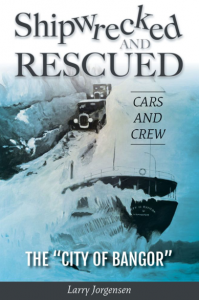Shipwrecked and Rescued – Larry Jorgensen
Shipwrecked and Rescued
Larry Jorgensen
 Growing up in the 1970’s in Marysville, Michigan, I used to watch the lake freighters travel up and down the St. Clair River all of the time. I remember one of the most fascinating ships to spot was the “Edmund Fitzgerald” at over 1000 feet in length. It was immortalized by the song, “The Wreck of the Edmund Fitzgerald” written by Gordon Lightfoot, after it encountered a severe Lake Superior winter storm in November 1975.
Growing up in the 1970’s in Marysville, Michigan, I used to watch the lake freighters travel up and down the St. Clair River all of the time. I remember one of the most fascinating ships to spot was the “Edmund Fitzgerald” at over 1000 feet in length. It was immortalized by the song, “The Wreck of the Edmund Fitzgerald” written by Gordon Lightfoot, after it encountered a severe Lake Superior winter storm in November 1975.
My own personal experience of how fast a storm can roll in from Lake Superior occurred Mothers Day in 1973. Our family drove almost 12 hours up to property we owned on Lake Bailey in the Keweenaw Peninsula. It was spring and the weather was beautiful. But we awoke the next morning to two feet of snow and bitter cold! And NOBODY had cold weather clothing! We were wearing shorts, T-shirts and flip flops! Needless to say, we loaded up the car and headed home!
I’m saying all this because our guest today has written a book titled, “Shipwrecked and Rescued, Cars and Crew.” It is about a famous event in Michigan history. A story of another shipping disaster on Lake Superior. Just so you know, there have been over 10,000 ship wrecks in the Great Lakes, about 500 or more in Lake Superior and many of them still remain undiscovered due to the depth of the Lake.
But “Shipwrecked and Rescued, Cars and Crew” is about a wreck that had a good ending. A rescue. Not just a rescue of the crew, but also the cargo. A tragedy that turned to victory. But it was not an easy feat to achieve.
Larry Jorgensen has been fascinated by the wreck of the ship called, “The City of Bangor.” This was not just a ship wreck. This was a double rescue success! What is a double rescue success? Well, instead of me telling you about it, let’s welcome to the program historian and author, Larry Jorgensen!
Larry, thank you for taking the time to join us today!
Larry, let’s jump into the book. What first caught your attention about the wreck of the “City of Bangor” and why?
This wreck occurred before there was, truly, any significant use of radio, radar and things like that which we take for granted today, correct?
Tell us about this wreck and what made the rescue so difficult and, at the same time, so significant…
The crew was taken in by a generous family that took care of them during the winter.
A local businessman, basically, “invented” the snowmobile” and it was successfully used in the rescue?
Once the crew was safe, then came the second part of the rescue, correct?
Tell us about that aspect of the rescue?
It took the highway department three weeks to plow the road 40 miles to get the cars back from Copper Harbor.
I just have to ask, do you speak “Yoopernese?”
For those that don’t understand, “Yoopernese” is the dialect, accent or whatever you want to call of northern Michiganders. It sounds something like, “yah, you dalk like dis when you live der, eh?”
Growing up in the thumb area of Michigan, I was referred to as a “Troll” (that’s what Yoopers call people from the lower peninsula because we live “under the bridge” – referring to, of course, the Mackinaw Bridge).
Anyway, I could talk for hours about the UP (for those that don’t know, that means the “Upper Peninsula”).
Larry, this is awesome. I truly appreciate you sharing this story with us. How can someone obtain their own copy of “Shipwrecked and Rescued, Cars and Crew?” Is it on Amazon?
If someone wanted to get in touch with you, maybe to ask a question or do an interview such as this, how can they do that? How can someone get in touch with you?
I’ll put links to all of this down in the show notes below.
CONTACT INFORMATION:
Website: https://shipwreckedandrescued.com
Email: glmanagement40@gmail.com